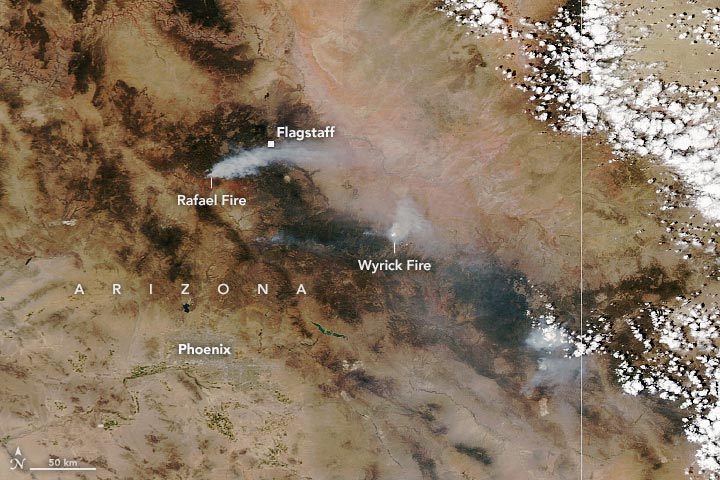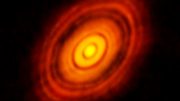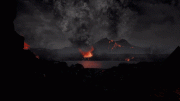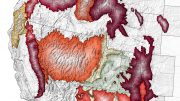Exceptional drought has gripped much of Arizona for months. In June 2021, a potent heat wave sent temperatures soaring above 115°F (46°C) on multiple days. Now extreme fires are raging throughout the state.
On June 21, 2021, the Moderate Resolution Imaging Spectroradiometer (MODIS) on NASA’s Aqua satellite captured this natural-color image of smoke streaming from several large fires in Arizona.
Dozens of fires were reported in Arizona and New Mexico in June 2021, according to data from the U.S. government fire information website InciWeb. Several blazes ignited when dry lightning struck already parched, heat-stressed landscapes.
Southwest of Flagstaff, the Rafael fire had charred more than 38 square miles (97 square kilometers) as of June 21, 2022. The fire prompted evacuations and road closures in several communities. Near Heber, the Wyrick fire had burned 11 square miles and triggered evacuations orders in Navajo County. In the far eastern part of the state near Alpine, the Horton Complex and Bear fires were generating significant amounts of smoke.
Two national forests—Coconino and Kaibab—in northern Arizona have taken the rare step of closing to protect public safety.
Human greenhouse gas emissions have likely left a fingerprint on the heat wave. “It may look similar to other heat waves on a weather map, but the magnitude, intensity and duration of the event is larger because of climate change,” said Michael Crimmins, a University of Arizona environmental scientist and a co-investigator for the CLIMAS Southwest Climate Assessment, in a perspective article written for The Washington Post.
NASA Earth Observatory image by Lauren Dauphin, using MODIS data from NASA EOSDIS LANCE and GIBS/Worldview.










“Human greenhouse gas emissions have likely left a fingerprint on the heat wave.”
That is really a stretch. The demise of the Chaco Canyon culture (Anasazi) is a clear example that the south west has experienced even worse, longer lasting droughts in the past, long before CO2 began to rise.
The average global temperature has increased about one degree F in the last 50 years. That global increase has been strongly influenced by Arctic increases, 2-3X the rest of the globe. The rest of the increase is dominated by increases at night and in the Winter in the mid-latitudes.
See my detailed analysis of heat wave history here:
https://wattsupwiththat.com/2019/09/06/the-gestalt-of-heat-waves/
If it appears that fires are more of a problem in the desert than in the past, one would do well to look elsewhere than ‘anthropogenic climate change.’
Humans may well be responsible, but in another way. From a SciTechDaily article last June: “There is also an abundance of fuel for the fire with INVASIVE GRASSES in the desert ecosystem, native grasses and low fuel moisture in the live plants.”
https://scitechdaily.com/wildfires-rage-in-arizona-and-new-mexico-as-seen-from-nasas-aqua-satellite/
The Sonora Desert is always at high fire risk just before the annual monsoon rains start in early-July. If the monsoon rains failed, that would be something for real concern.
Appears we have a winner. Thinking those “annual monsoon rains” might want to actually become a thing again? Interesting, the mixing of facts and prejudices co mingled to create confusions.
Are you suggesting that the Sonora Desert monsoon rains are a thing of the past? Do you have a citation to support that?
“Interesting, the mixing of facts and prejudices co mingled to create confusions.”
That would seem to describe what you have just done!